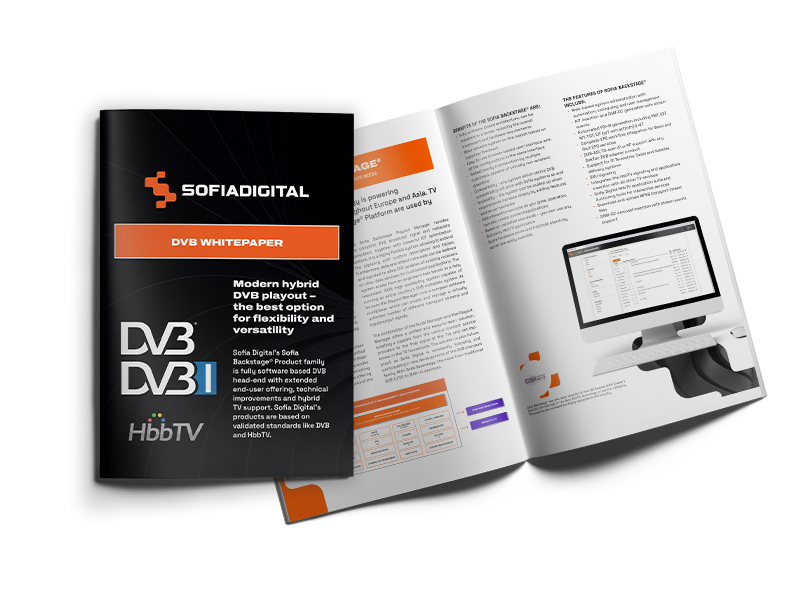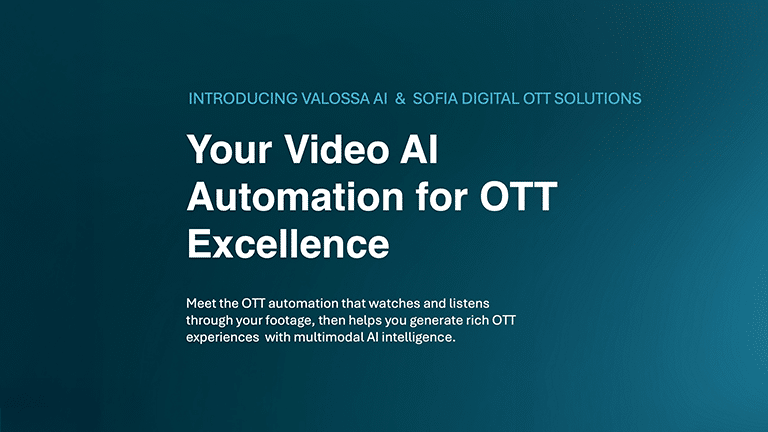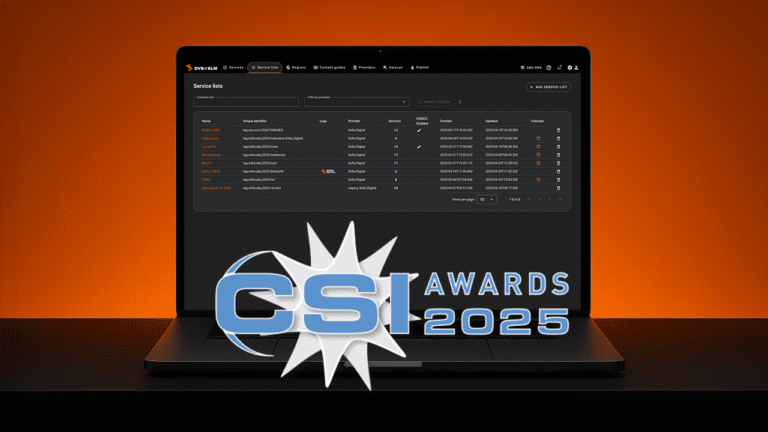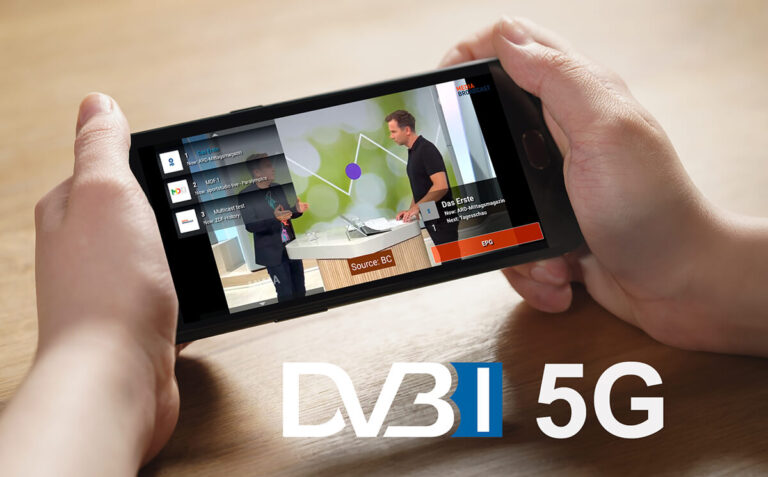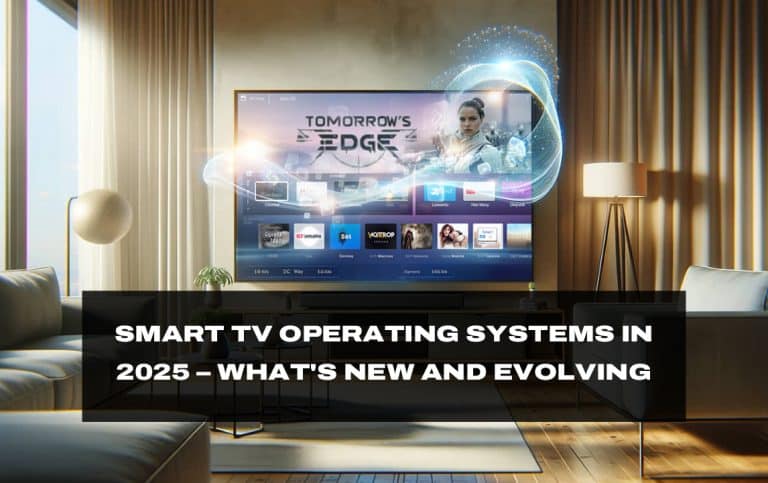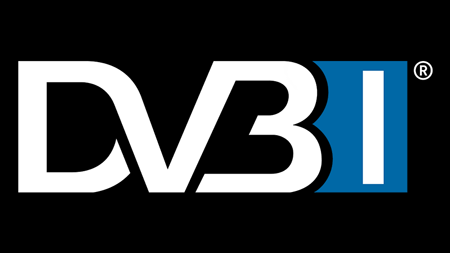
In this article
Television distribution is undergoing a significant transformation. As streaming platforms grow in popularity and broadcast audiences evolve, there is a need for technology that bridges traditional broadcasting with modern broadband delivery. DVB-I is an open standard designed to do just that.
DVB-I enables broadcasters and content providers to deliver services seamlessly across broadcast and broadband networks. It combines the strengths of traditional television with the flexibility of internet streaming, offering an integrated user experience and ensuring compatibility with a wide range of devices.
What is DVB-I?

DVB-I, or Digital Video Broadcasting – Internet, is a standard that supports the delivery of television services across different networks. It allows viewers to access live (linear) and on-demand content through an unified interface, whether the content is delivered via terrestrial, satellite, cable, or IP networks or even 5G broadcast.
Key Features of DVB-I metadata
- Network-Agnostic Delivery: Ensures are accessible across any combination of broadcast and broadband networks.
- Integrated Program Guide: Provides a unified guide that combines both broadcast and streaming channels.
- Flexible Quality Management: Adapts to the capabilities of the user’s device and the quality of the network connection.
- Support for Advanced Formats: Enables high-quality video formats, including UHD and HDR and supports next-generation audio.
- Dynamic Content Management: Allows broadcasters to create temporary pop-up channels or thematic streams for specific events.
- Device Interoperability: Works with a range of devices, including legacy Smart TVs, modern IP-only devices and multiscreen setups.
- Efficient Resource Use: Minimizes bandwidth use for traditional broadcasts while leveraging IP for scalable, high-quality streaming.
By integrating these capabilities, DVB-I creates a seamless viewing experience that combines the reliability of traditional television with the flexibility of modern streaming services.
Why Adopt DVB-I?
DVB-I offers substantial advantages for broadcasters, operators, streaming platforms, device manufacturers and viewers. It addresses key challenges in delivering TV services and positions stakeholders for success in an evolving digital media landscape.
For Broadcasters and operators
- Seamless Transition to Hybrid Models: DVB-I supports the coexistence of traditional broadcast and broadband delivery, allowing broadcasters to maintain continuity for viewers as they migrate to IP-based services.
- Cost Efficiency: By reducing reliance on traditional spectrum, DVB-I leverages broadband networks for scalable and cost-effective content delivery.
- Enhanced Viewer Retention: Unified program guides and consistent user experiences across devices help broadcasters retain audiences even as viewing habits shift.
- Innovative Content Opportunities: Enables features like pop-up channels for events, thematic programming and higher-quality streams (e.g., 4K, HDR) to meet evolving audience demands.
For Streaming Platforms
- Greater Visibility: DVB-I allows streaming services to integrate into traditional linear program guides, moving beyond app-based ecosystems and reaching audiences who prefer familiar EPG navigation.
- Linear Channel Opportunities: Provides an efficient entry point for creating streamed linear channels without the infrastructure costs of traditional broadcasting.
For Device Manufacturers
- Improved User Experience: DVB-I integration enhances TV interfaces by providing seamless navigation between broadcast and streaming channels.
- Consumer Appeal: Supports advanced features such as high-quality video formats and real-time service switching, making DVB-I-enabled devices attractive to buyers.
For Viewers
- Unified Experience: DVB-I combines all available content—broadcast and broadband—into a single, easy-to-use interface.
- Improved Access to services: Ensures access to TV services even in areas with limited broadcast coverage by leveraging broadband networks.
- Higher Quality Content: Adapts video and audio quality to the capabilities of the viewer’s device, offering superior viewing experiences.
Who Should Use DVB-I?
DVB-I’s versatility makes it relevant for a wide range of stakeholders in the television and streaming ecosystem. It serves as a solution for those seeking to improve service delivery, adapt to changing audience expectations, or future-proof their operations.
Broadcasters
- Traditional Broadcasters: DVB-I allows broadcasters to integrate IP-based streaming while maintaining their presence in program guides. This ensures continuity for audiences transitioning away from traditional DTT or satellite systems.
- Public Broadcasters: Ensures visibility and prominence in hybrid program guides, even as broadcast spectrum usage decreases.
- Event Broadcasters: Supports temporary or event-specific pop-up channels for live coverage without requiring additional broadcast spectrum.
Streaming Platforms
- FAST (Free Ad-Supported Streaming TV) Operators: DVB-I enables FAST channels to move beyond app ecosystems and gain prominence in linear program guides.
- Born-Digital Services: Offers new opportunities for streaming services to integrate into traditional TV experiences, reaching broader audiences through familiar navigation methods.
Device Manufacturers
- Smart TV Producers: DVB-I can enhance device functionality with integrated program guides that merge broadcast and broadband content.
- Set-Top Box Providers: Ensures compatibility with the latest standards, appealing to operators seeking hybrid solutions.
Content Aggregators
- Companies creating integrated service lists and EPGs can leverage DVB-I to expand their offerings and provide unified content experiences.
Regulators and Policymakers
- DVB-I offers a pathway to ensure fair and regulated access to hybrid program guides, helping establish frameworks that benefit both traditional broadcasters and new entrants.
Advertisers
- DVB-I opens new opportunities for targeted advertising through hybrid program guides, especially as it bridges linear and on-demand content.
DVB-I Pilots
DVB-I has been tested in real-world environments, proving its potential to reshape television distribution. Pilots in Italy, Germany, Spain and Ireland have explored use cases such as spectrum challenges, integrating interactivity and expanding hybrid TV platforms. These projects highlight how DVB-I adapts to different regions and scenarios.
For a detailed overview of DVB-I deployments, please visit dvb-i.tv/deployments.
The Future of DVB-I
DVB-I is not just a solution for today’s challenges but a foundational technology shaping the future of television distribution. As the TV ecosystem continues to evolve, DVB-I offers broadcasters, operators and viewers a path to adapt to changing technologies and viewing habits.
Key Trends Shaping the Future of DVB-I
- Full IP Ecosystems: With increasing adoption of broadband, DVB-I positions itself as a critical tool for creating IP-only environments, ensuring seamless service even in the absence of traditional broadcast infrastructure.
- Advanced Video and Audio Formats: DVB-I’s support for UHD, HDR and next-generation audio formats ensures compatibility with evolving consumer expectations for high-quality content.
- Interactive and Personalized Viewing: By integrating with technologies like HbbTV, DVB-I enables personalized program guides, interactivity and advanced features such as multicamera views and tailored recommendations.
Potential Applications
- Super-Aggregation: DVB-I can act as the backbone for super-aggregators, combining content from multiple sources into a unified program guide.
- Pop-Up and Thematic Channels: Event-based or niche-focused channels can become more prominent, with broadcasters and streamers using DVB-I to create temporary or highly targeted content.
- Expansion Beyond Broadcast: DVB-I’s open framework allows born-digital streamers, FAST platforms and non-traditional players to integrate into hybrid EPGs, expanding their reach.
Challenges to Address
- Global Standardization: Ensuring consistent implementation across markets will require collaboration between broadcasters, device manufacturers and regulators.
- Regulatory Evolution: Policymakers will need to adapt regulations to accommodate hybrid models, ensuring fair access for new entrants while maintaining broadcaster prominence.
The Long-Term Vision
DVB-I has the potential to redefine television distribution as a unified, hybrid model. By combining the strengths of traditional broadcasting and broadband streaming, it ensures a seamless viewing experience while providing tools for innovation in content delivery. As broadcast spectrum becomes increasingly limited, DVB-I could serve as the bridge to a fully IP-driven future, ensuring continuity for viewers and opportunities for broadcasters.
Challenges in Adopting DVB-I
While DVB-I offers significant opportunities, its implementation comes with certain challenges. Understanding these obstacles is critical for broadcasters, streaming platforms and device manufacturers to successfully adopt the technology.
- Managing Hybrid Services
- Challenge: Combining broadcast and broadband services requires sophisticated tools to handle service metadata, program guides and content delivery across multiple platforms.
- Solution: A robust service management platform, like Sofia Digital’s DVB-I Service Manager, simplifies the process by centralizing metadata creation and delivery for hybrid models.
- Regulatory Compliance
- Challenge: Ensuring DVB-I aligns with local and international broadcasting regulations, especially when integrating with legacy infrastructures.
- Solution: Early collaboration with regulators and adopting tools that adhere to established frameworks can minimize disruptions and compliance risks.
- Device Compatibility
- Challenge: DVB-I must work seamlessly across a wide variety of devices, from older Smart TVs to IP-only screens and multiscreen setups.
- Solution: Standards-compliant testing frameworks and close collaboration with device manufacturers are essential to guarantee compatibility.
- Transition Logistics
- Challenge: Shifting from traditional broadcast delivery to a hybrid or fully IP-based model without losing viewers or service quality.
- Solution: DVB-I supports gradual transitions, allowing broadcasters to deliver both broadcast and IP versions of the same channel while maintaining a consistent viewer experience.
- Viewer Experience Continuity
- Challenge: Delivering a seamless and intuitive interface that integrates DVB-I with existing services, including logical channel numbers and familiar program guide navigation.
- Solution: Thoughtful UX design and service management tools ensure consistency and ease of use for viewers.
- Technical Resource Requirements
- Challenge: Implementing DVB-I requires technical expertise, including setting up low-latency streaming, ensuring high-quality encoding and integrating advanced formats like UHD and HDR.
- Solution: Partnering with experienced technology providers can streamline the process and provide access to the necessary expertise.
- Fair Market Access for New Entrants
- Challenge: Born-digital platforms and streaming services need fair access to DVB-I program guides, raising concerns about regulatory frameworks and equal treatment.
- Solution: Transparent policies and equitable service list inclusion criteria are critical to fostering innovation and competition.
- Overcoming these challenges requires the right tools and expertise. Solutions like Sofia Digital’s DVB-I Service Manager address many of these issues, providing broadcasters and operators with the tools needed to manage hybrid services and deliver consistent, high-quality viewer experiences.
Frequently Asked Questions (FAQ)
Yes, DVB-I leverages broadband networks to complement traditional broadcast delivery. This ensures that viewers in areas without reliable terrestrial or satellite coverage can still access high-quality TV services via broadband mobile networks.
DVB-I helps broadcasters address spectrum re-allocation challenges by enabling content delivery over IP. This ensures that prominent services and channels remain accessible through program guides even as spectrum use decreases.
DVB-I integrates broadcast and broadband services into a single, unified program guide. It allows seamless switching between traditional and streamed channels, supports dynamic content like pop-up channels and ensures logical channel navigation across devices.
DVB-I supports live sports, enabling features like low-latency streaming and real-time switching between broadcast and IP streams. Pilots, such as Spain’s RTVE tennis coverage, have demonstrated its effectiveness in delivering high-quality, event-specific channels.
DVB-I is compatible with a range of devices, including Smart TVs, set-top boxes and IP-only devices like tablets and smartphones. Many devices can be made DVB-I-capable through firmware updates. Stand-alone applications can be built to support DVB-I features.
DVB-I supports high-quality formats such as UHD and HDR. It allows broadcasters to deliver these formats to capable devices while maintaining compatibility with legacy systems using standard-definition or HD formats.
Regulatory challenges include ensuring fair access to DVB-I service lists, addressing prominence rules and maintaining compatibility with existing broadcast regulations. Early collaboration with policymakers is essential for smooth adoption.
Yes, DVB-I integrates with HbbTV to enhance interactivity. For example, it can launch applications directly from the program guide, allowing viewers to access VOD libraries or additional content. HbbTV can also be used for user access management and DRM.
DVB-I is poised to become a cornerstone of hybrid television. It supports the shift to IP-based delivery while preserving the benefits of traditional broadcasting, making it a critical tool for adapting to the evolving TV landscape.
DOWNLOAD OUR COMPREHENSIVE DVB WHITEPAPER
DVB is the international open standard for digital broadcasting with over 1 billion compatible receivers deployed. In our free whitepaper you will learn the benefits in switching from a hardware-based head-end to a software solution.
